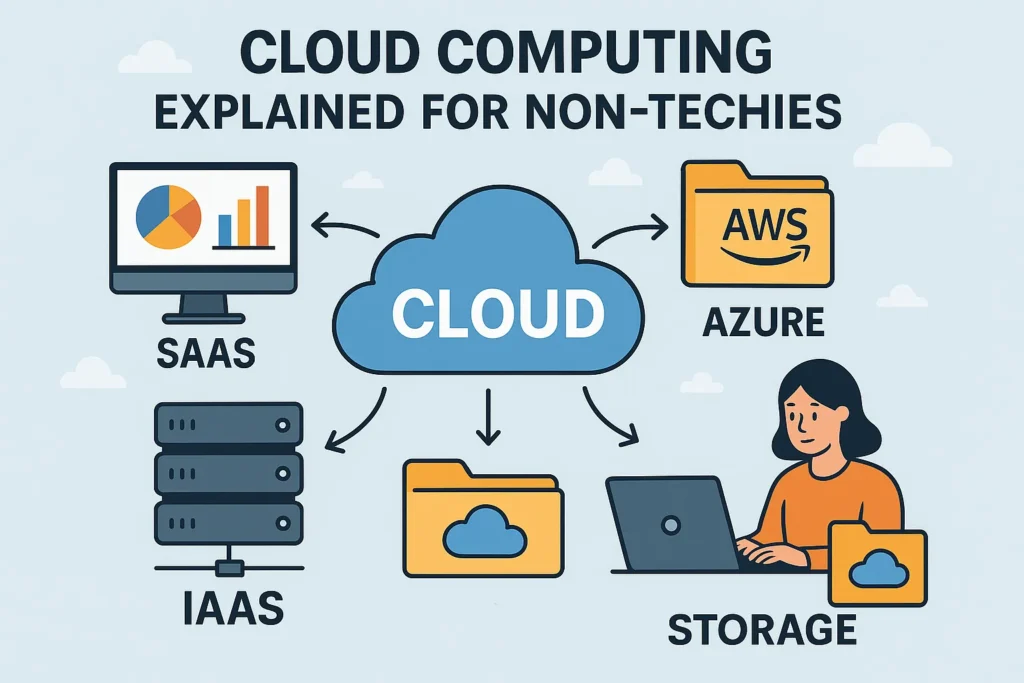The term “the cloud” is frequently encountered in daily conversations, often evoking a sense of something important yet vaguely understood.
For many, especially those new to cloud computing for beginners, it remains an ethereal concept, a mysterious digital realm where data resides.
This report aims to demystify cloud computing for beginners by revealing what it truly is, how it functions, and its profound impact on personal and professional lives.
What is Cloud Computing?
At its core, cloud computing, augmented by virtualization technology, represents the on-demand delivery of IT resources and applications over the internet, operating on a pay-as-you-go pricing model.
This signifies a fundamental shift from the traditional approach of owning, purchasing, and maintaining one’s own computing infrastructure to simply accessing technology services provided by major cloud companies such as Amazon Web Services (AWS), Google Cloud, or Microsoft Azure.
These services encompass a wide array of offerings, including software-as-a-service, platform-as-a-service, computing power, data storage, and databases, with Microsoft Azure being a prominent player in the cloud computing arena.
The Grid Analogy
To grasp this concept, consider the analogy of an electrical grid.
Just as individuals and businesses do not generate their own electricity but instead plug into a vast power grid, cloud computing allows users to tap into an extensive network of computing power and services.
This utility-like model replaces substantial upfront investment in physical infrastructure with a flexible, usage-based cost.
The Economic Impact
This economic transformation significantly lowers the barrier to entry for startups, small and medium-sized businesses, and even individual developers.
They can now access enterprise-grade infrastructure and sophisticated tools without the prohibitive initial capital investment required for traditional IT setups.
This fosters increased innovation and faster market entry for new ideas.
By abstracting away the complexities of managing physical IT infrastructure, cloud computing enables businesses to focus on their core competencies and on innovating new products and services.
Reducing Technical Debt
This directly contributes to a reduction in “technical debt” and accelerates product development cycles, leading to faster time-to-market for new features and applications.
This report will break down cloud computing into components, illustrating its practical applications in everyday life and business, and provide insights into cloud computing for beginners.
Why Everyone’s Talking About the Cloud: Key Benefits
The widespread adoption of cloud computing is driven by a compelling set of advantages. These benefits extend beyond mere convenience, fundamentally reshaping how technology is consumed and managed.
Saving Money: No Big Upfront Costs
One of the most attractive aspects of cloud computing is its transformative financial model. Traditionally, acquiring IT infrastructure involved significant upfront capital expenditures (CapEx) for purchasing servers, networking equipment, and software licenses.
Cloud computing shifts this to an operational expenditure (OpEx) model, where users pay only for the resources they consume. This financial flexibility allows powerful, enterprise-grade computing resources to be accessible to businesses of all sizes, including startups.
This democratization of advanced IT infrastructure levels the competitive playing field, allowing smaller entities to compete more effectively with established players.
Growing with Ease: Scalability and Flexibility
Cloud environments offer unparalleled scalability and elasticity by utilizing remote servers. Computing resources, such as processing power or storage space, can be rapidly increased or decreased as needed.
For example, a retail website can handle a sudden surge in traffic during a major holiday sale without crashing and then scale back during quieter periods to optimize costs.
This inherent flexibility prevents costly over-provisioning and performance bottlenecks.
Access Anywhere, Anytime: Convenience and Collaboration
Cloud services dramatically enhance accessibility. Users can access their applications, documents, and data from any internet-connected device, regardless of their location.
This flexibility is a cornerstone of modern remote work models, facilitating global collaboration among distributed teams.
Businesses become more resilient to localized disruptions, enabling truly distributed workforces.
Keeping Things Running: Reliability and Disaster Recovery
Leading cloud providers design their cloud architecture with high availability and fault tolerance as core principles. They achieve this by distributing data and applications across multiple, geographically dispersed data centers.
This redundancy ensures greater reliability and resilience against localized outages or hardware failures, providing a robust framework for disaster recovery.
The Cloud’s Menu: Understanding Service Models (IaaS, PaaS, SaaS)
Cloud services are not a monolithic entity; rather, they come in different “flavors” or “menus,” each offering varying levels of management responsibility and control.
A simple analogy can help differentiate these models: consider ordering food at a restaurant.
Software as a Service (SaaS): Ready-to-Use Apps
SaaS, or software-as-a-service, is the most common and user-friendly cloud model, akin to buying a ready-made meal that is fully prepared and ready to eat. Users access complete software applications over the internet, typically on a subscription basis.
The cloud provider manages everything, from the underlying servers and databases to the networking and software updates. Users, especially those interested in cloud computing for beginners, simply log in and use the application.
Widely recognized examples include Gmail, Salesforce, and Netflix, all of which exemplify the “plug-and-play” nature of SaaS.
Companies can instantly deploy ready-made business solutions like customer relationship management (CRM) or enterprise resource planning (ERP) without any IT setup or maintenance, significantly accelerating their innovation cycles.
Platform as a Service (PaaS): Tools for Developers
PaaS can be likened to ordering a meal kit, where ingredients and a recipe are provided, and the user cooks the meal. This model provides a comprehensive platform-as-a-service for developers to build, run, and manage applications without the burden of building and maintaining the underlying infrastructure.
It includes essential components such as operating systems, programming language execution environments, databases, and web servers.
The provider handles all the “under-the-hood” infrastructure management, allowing developers to focus solely on writing and deploying their application code.
Examples include Google App Engine, Azure, and AWS Elastic Beanstalk.
With PaaS, developers are freed from time-consuming tasks like provisioning and managing servers, operating systems, and databases, allowing them to dedicate nearly all their effort to writing and deploying the actual application code that delivers business value.
Infrastructure as a Service (IaaS): The Building Blocks
IaaS, or infrastructure-as-a-service, is comparable to buying raw ingredients, where the user prepares everything from scratch, including setting up the kitchen.
This model gives users access to fundamental computing resources over the internet, such as virtual machines (virtual computers), storage, networks, and operating systems, which are integral components of cloud computing.
Users have the highest level of control and flexibility: they manage their applications, data, runtime environments, and middleware, while the cloud computing provider manages the core virtualization technology, physical servers, storage hardware, and networking.
Examples include Amazon EC2 and Microsoft Azure Virtual Machines.
These service models represent a spectrum of control versus convenience, directly impacting the technical expertise required and the target users, making it essential to understand cloud computing for beginners.
The increasing abstraction offered by PaaS and SaaS accelerates innovation cycles for businesses by shifting focus from infrastructure to application logic. This significant reduction in operational overhead means businesses can bring new products, features, and services to market much faster, translating into competitive advantage and enabling rapid iteration and quicker responses to market demands.
Table 1: Cloud Service Models at a Glance
|
Model |
What it offers |
Who manages what |
Analogy |
Common Examples |
|---|---|---|---|---|
|
SaaS |
Complete, ready-to-use applications |
The provider manages everything |
Ready-made meal |
Gmail, Netflix, Salesforce |
|
PaaS |
A platform for building and running apps |
The provider manages the infrastructure and platform, user manages applications/data |
Meal kit |
Google App Engine, AWS Elastic Beanstalk |
|
IaaS |
Virtualized computing resources like servers, storage, and networks |
The provider manages the core infrastructure, user manages OS, applications, and data |
Raw ingredients |
Amazon EC2, Microsoft Azure Virtual Machines |
Where Does the Cloud Live? Deployment Models
Beyond understanding what services are offered, it is also important to consider how cloud architecture is set up and where it physically or logically resides, especially for those new to cloud computing for beginners.
Public Cloud: Shared Resources for Everyone
The public cloud is the most common deployment model, where computing resources (such as servers and storage) are owned and operated by a third-party cloud service provider (e.g., AWS, Google Cloud, Microsoft Azure) and delivered over the internet. These resources are shared among multiple organizations, often referred to as “tenants.”
Despite sharing infrastructure, each tenant’s data and applications are logically separated and secure.
Private Cloud: Your Own Dedicated Space
A private cloud refers to cloud computing resources used exclusively by a single organization. This dedicated environment can be physically located on the company’s own on-site data center or hosted by a third-party service provider.
The primary benefit of a private cloud is enhanced control, greater customization possibilities, and it is often a preferred choice for organizations with stringent regulatory compliance requirements or highly sensitive data.
Hybrid Cloud: The Best of Both Worlds
The hybrid cloud is a flexible combination of public and private clouds, allowing data and applications to be shared and moved seamlessly between them.
This model offers the best of both worlds: organizations can leverage the cost-effectiveness and scalability of the public cloud for less sensitive applications while keeping critical data and highly sensitive applications in the private cloud for enhanced security or compliance needs.
The decision of where to deploy cloud computing resources is a strategic business imperative driven by specific organizational needs, risk tolerance, and regulatory environments.
Table 2: Cloud Deployment Models Compared
|
Model |
Ownership/Access |
Key Benefits |
Best For |
Analogy |
|---|---|---|---|---|
|
Public Cloud |
Third-party owned, shared among multiple users |
Cost-effective, high scalability, low maintenance |
General applications, startups, variable workloads |
Apartment building |
|
Private Cloud |
Exclusively used by a single organization |
Enhanced control, customization, and strong security for sensitive data |
Highly sensitive data, strict regulatory compliance, and large enterprises |
Your own house |
|
Hybrid Cloud |
A combination of public and private, allowing data/apps to be shared |
Flexibility, cost optimization, and compliance for mixed workloads |
Mixed IT environments, gradual cloud migration, balancing security/cost |
House + vacation rental |
Addressing Common Worries: Security and Privacy in the Cloud
For anyone considering entrusting their data to cloud computing, where remote servers are used, security and privacy are valid and paramount concerns.
A critical concept in cloud security is the “shared responsibility” model. This model clarifies that the cloud provider is responsible for the security of the cloud (e.g., the physical security of data centers, the underlying hardware, network infrastructure, and hypervisor), while the customer is responsible for security in the cloud (e.g., securing their data, managing user access, configuring applications, and encrypting sensitive information).
An analogy helps illustrate this: the cloud provider builds a highly secure, impenetrable vault (the cloud infrastructure), but the customer is responsible for what is put inside the vault and who is given the keys.
Simply migrating data or applications to the cloud does not automatically make them perfectly secure; misconfigurations, poor access management, or unencrypted data can lead to significant vulnerabilities, regardless of the provider’s underlying security.
Reputable cloud providers like Azure invest massively in robust, state-of-the-art security measures.
These include advanced encryption protocols, multi-factor authentication (MFA), sophisticated intrusion detection systems, and regular, rigorous compliance audits.
Who Owns My Data? Privacy and Compliance
Concerns about data privacy and ownership are critical. While cloud providers typically outline their data handling policies in detailed service agreements, it is imperative for users to carefully review these terms.
Reputable providers adhere to international data protection regulations, such as GDPR, demonstrating a strong commitment to user privacy and data sovereignty.
The Cloud in Your Daily Life: Real-World Examples
The abstract concepts of cloud computing for beginners can be challenging to grasp, yet these are deeply integrated into everyday experiences, making the technology indispensable in modern life.
Streaming Movies and Music
Popular streaming services like Netflix and Spotify rely entirely on cloud computing architecture and infrastructure. These platforms use the cloud to store vast libraries of content and to deliver this content on demand to millions of users globally, without requiring users to download files locally onto their devices.
Online Shopping and Banking
Virtually all e-commerce websites and online banking platforms leverage infrastructure-as-a-service in the cloud. The cloud securely stores customer data, processes countless transactions, manages inventory, and ensures the seamless, reliable operation of these services, enabling secure purchases and financial management from anywhere.
Social Media and Photo Storage
Ubiquitous platforms like Facebook and Instagram depend on the cloud to store billions of photos and videos, manage real-time interactions, and ensure instant access to user-generated content.
Personal online file storage solutions like Google Drive and Dropbox are classic examples of cloud computing, allowing users to store, access, and share documents, photos, and other files.
Working Remotely and Collaborating
Cloud-based email services such as Gmail and Outlook, along with business applications like CRM systems, ERP software, and software-as-a-service platforms, have become essential tools for remote work and collaboration. These cloud services enable distributed teams to work together on documents, projects, and communications in real-time.
Looking Ahead: The Future of Cloud Computing
Cloud computing is a dynamic field characterized by continuous innovation and a growing impact across various sectors, making it essential to understand cloud computing for beginners.
New Innovations and Trends
The cloud is constantly evolving and integrating with cutting-edge technologies. Its future is closely tied to emerging areas like edge computing, artificial intelligence (AI), and the Internet of Things (IoT).
Cloud providers are increasingly embedding advanced AI and Machine Learning (ML) capabilities directly into their services, making sophisticated data analysis and intelligent automation more accessible.
The Cloud’s Growing Importance
Edge computing extends the cloud’s reach closer to the data sources, reducing latency and enabling real-time processing.
Serverless computing, containerization, and virtualization technology are becoming more prevalent. These trends further abstract infrastructure complexities, allowing developers even greater efficiency and speed in deploying applications.
Cloud computing will continue to be a foundational technology, not only supporting existing digital services but actively driving future innovations.
Related Internal Links (Reads You May Like):
- Affiliate Marketing: The Ultimate Guide in 2025 [Expert Insights + Proven Tips]
- Start Dropshipping with No Money: A Beginner’s Guide
- Chrome Extensions for Workflow: Boost Productivity
- Top 10 AI Image Generators for Beginners (Free & Paid)
- 25 Costly Mistakes New Bloggers Make (And How to Avoid Them Like a Pro)
Conclusion: Your Cloud Journey Begins
Cloud computing for beginners, once a mysterious concept, is now clearly understood as the on-demand, pay-as-you-go access to IT resources over the internet.
Its major benefits include significant cost savings, unparalleled scalability, global accessibility, and inherent reliability.
Cloud computing is not a distant concept but an integral, fundamental part of daily life and modern business operations.
The “utility” model of cloud computing fundamentally shifts user expectations from ownership to access. This signifies a fundamental change in how goods and services are consumed and delivered in the digital age, emphasizing flexibility, continuous value delivery, and access over outright ownership.
Cloud computing will continue to evolve rapidly, shaping the future of technology and its interaction with society.


